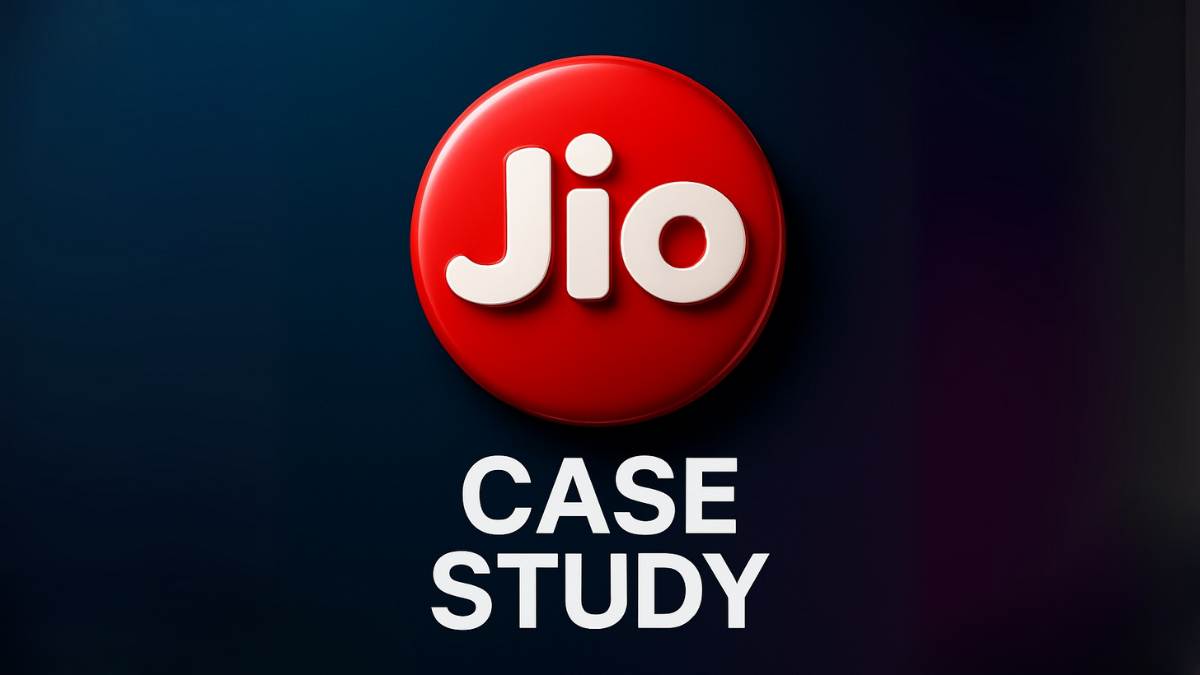Remember that wild time when everyone was running around asking, “Did you get your Jio SIM yet?”
Long queues outside Reliance stores. Friends passing around referral codes. Some people carrying two, even three phones, just to make sure they didn’t miss out on the free internet revolution.
It was chaos, but the good kind.
This wasn’t just a new telecom service launching. It was a marketing masterstroke.
Jio didn’t just sell a product, they offered an irresistible experience: Unlimited free calls. Free internet. No fine print. What started as a free offer quickly became a habit, and today, it dominates India’s telecom market like nothing before.
In this Jio case study, we’ll break down how they did it. The strategy behind the madness. The smart digital campaigns, the emotional storytelling, the pricing tactics that got everyone hooked.
And why this still matters in 2025, because whether you’re a brand, a marketer, or just someone fascinated by marketing genius, what Jio pulled off is a textbook example of disruptive marketing done right.
Let’s break it down.
Table of Contents
About Reliance Jio
Reliance Jio is a subsidiary of Reliance Industries Limited (RIL), founded by Mukesh Ambani. It officially launched its services in September 2016 but had been quietly building its infrastructure years before that.
Mission: To digitally empower every Indian, offering affordable connectivity and next-gen digital services.
What started as a simple telecom provider quickly transformed into a digital ecosystem. Today, Jio’s offerings include mobile services, fiber broadband, OTT content, entertainment apps, and even hardware like JioPhone and JioBook.
A quick glance at Jio’s journey:
- 2010: Reliance acquires Infotel Broadband (the only company to win 4G spectrum in all 22 circles of India).
- 2016: Jio’s commercial launch, with free internet and calls.
- 2020: Facebook (now Meta) invests $5.7 billion in Jio Platforms.
- 2025: Jio is now a digital behemoth with millions of users across its services.
Also Read: Zara Case Study
Jio’s Target Customer Segments
Before we dive into the strategies, it’s crucial to understand who Jio was really targeting.
1. Price-Conscious Users
Let’s be honest, India is a price-sensitive market. Especially when it comes to data and call rates. Before Jio, most people used the internet carefully, counting megabytes, afraid of those massive recharge bills.
Jio saw this pain point, and flipped it.
2. Quality-Conscious Users
The other side? Users who wanted fast, reliable internet. Especially urban professionals, students, content creators, and businesses who needed more than just cheap rates. They wanted speed, reliability, and access to global platforms like YouTube, Netflix, and WhatsApp without buffering issues.
By understanding these two major segments, Jio was able to tailor its messaging and offerings in a way that no one else in the market was doing at the time.
Also Read: Netflix Case Study
Marketing Strategy of Reliance Jio
Here’s where it gets really interesting, and why this Jio case study deserves your full attention.
1. Launching with a Freemium Model: The Game-Changer
Imagine this: Unlimited free internet. Unlimited free calls. No catches.
That’s what Jio offered during its launch phase. For months, people across India could use mobile data without paying a rupee.
And this wasn’t just a discount or a trial, it was a mass adoption strategy.
By offering free data:
- Jio attracted millions of users overnight.
- Competitors scrambled to respond, cutting prices drastically.
- Price-sensitive users felt they were finally getting what they deserved, value for money.
Fun fact? Even people who didn’t need a Jio SIM got one, just for backup. That’s how powerful the offer was.
2. Digital-First Marketing: Social Media & YouTube Domination
While telecom ads were traditionally run on TV and radio, Jio went digital-first. Why? Because their target users, especially younger Indians, were spending more time on social media than watching TV.
Social Media Platforms Jio Focused On:
- Instagram & Facebook for mass reach
- Twitter for brand announcements and real-time engagement
- YouTube for both ads and organic content strategies
And here’s the clever part, they didn’t just go for pan-India, English-only ads. They tailored regional content, running YouTube ads in regional languages to deeply connect with diverse communities.
One standout strategy was creating short, emotional ads that could work both online and on TV. These ads tapped into themes like family connections, national pride, and future possibilities.
Think about it, everyone loves free internet, but Jio made it emotional. “We’re not just giving you data, we’re helping you video call your family, watch cricket matches, and grow your small business.”
That’s next-level marketing.
3. Purpose-Driven Messaging
The other brilliant move? Aligning with India’s Digital Growth story.
Jio positioned itself not just as another telecom provider, but as a partner in India’s future.
By tying their campaigns to initiatives like Digital India, they gave their brand a national purpose. It wasn’t just about selling SIM cards anymore, it was about empowering India.
That kind of messaging builds trust, especially in a country where patriotism and community progress resonate deeply.
4. Strategic Partnerships & Influencer Collaborations
Jio didn’t stop at emotional ads and pricing tricks.
They went a step further with partnerships:
- OTT Platforms: Jio tied up with Hotstar (now JioHotstar), Eros Now, and others to offer exclusive content to its users.
- Entertainment & Sports: Cricket partnerships during IPL seasons, plus Bollywood star endorsements.
- Influencer Collaborations: They worked with influencers on YouTube and Instagram to break down Jio’s offerings in relatable, everyday content.
This wasn’t random, it was all carefully designed to create maximum relevance for multiple audience segments.
And guess what? It worked.
5. Smart Pricing Models & Bundling
Free data wasn’t forever. Eventually, Jio introduced paid plans, but they were unbelievably competitive.
They rolled out bundles that included:
- Postpaid Plans with Netflix/OTT add-ons
- JioFiber for home internet
- Massive data packs for students, gamers, and streamers
And because they already owned the attention of the masses, millions happily paid.
To put this in perspective, Jio wasn’t winning on price alone. They were winning on perceived value.
(Want to learn how to create irresistible marketing offers like this? Check out our Digital Marketing Course to start mastering strategies like these yourself.)

How Jio Dominated a Saturated Market (Red Ocean Strategy)
When Jio entered the Indian telecom scene, it didn’t enter a friendly space. It jumped into a full-fledged Red Ocean, a bloody price war where every operator was fighting for survival. But Jio didn’t fight with the same old tactics, it rewrote the whole game.
Here’s how they did it:
1. Jio’s Entry in a Price War Market
Before Jio, telecom operators like Airtel, Vodafone, Idea were already competing on call rates and limited data packs. Jio didn’t just join that price war, it blew it apart by offering everything for free. Free calls. Free data. Free apps. It was like entering a boxing match with a bazooka.
This wasn’t about being slightly cheaper. It was about being so much better that no competitor could catch up.
2. Leveraging Data as the “New Oil”
Mukesh Ambani famously said: “Data is the new oil.”
And Jio wasn’t giving away free internet as a charity project, they were playing the long game. By flooding the market with cheap or free data, they made Indians data-hungry. Once people were hooked on video calls, YouTube, IPL streaming, they could never go back to slow, overpriced internet.
This shift positioned Jio as the future of India’s digital consumption.
3. Creating Demand Where it Didn’t Exist (e.g., Rural Smartphone Users)
Before Jio, rural smartphone users didn’t really stream videos or binge-watch cricket on mobile. Why? It was expensive, and frankly, hard to access.
Jio didn’t just serve existing demand, it created new demand. Free 4G internet meant even villages started streaming YouTube, downloading apps, video calling relatives abroad.
Suddenly, millions of new customers entered the market, and guess who they trusted? The company that brought them online in the first place: Jio.
4. Competitors Were on the Verge of Exiting
It wasn’t just smaller players, big names almost collapsed. Vodafone and Idea had to merge in 2018 just to survive Jio’s storm. Others like Aircel, Tata Teleservices, and Videocon, just disappeared.
A senior TRAI official even said:
“No one had imagined that a company with such deep pockets would come in at such a large scale and start offering free services… The consolidation led by the so‑called data wars pushed even more companies out of the sector.”
It was one of the most brutal market disruptions India has seen.
Sources: indianexpress
5. Hooking Users First, Charging Later
Here’s the cleverest bit, Jio gave everything free first. By the time people got used to unlimited data, they didn’t want to switch back to anyone else.
When Jio finally started charging? People shrugged and thought,
“Well… changing numbers is too much work anyway. Let’s just keep this.”
And guess what? Those prices that started cheap? Today, they’re not so cheap anymore, but by now, Jio’s users are locked in.
Also Read: Uniqlo Case Study
Popular Marketing Campaigns by Reliance Jio
Jio didn’t just rely on offers, it marketed smart. Here are some of their most iconic campaigns:
1. Get Jio SIM Home Delivered
When standing in queues started turning people off, Jio made it ridiculously simple: Get your Jio SIM delivered to your doorstep. Talk about convenience. It worked especially well during lockdowns and for senior citizens or busy professionals.
2. Cheer for India Campaign (Cricket)
Jio tapped into India’s cricket obsession by launching emotional, patriotic campaigns during major tournaments. “Cheer for India” became more than just a telecom ad, it was a national feeling. Everyone wanted to be part of it.
3. IPL’s Cricket Play Along
Jio wasn’t just running ads during IPL, they created interactive experiences like “Cricket Play Along,” where users could predict scores, win prizes, and engage during matches. This wasn’t passive marketing, it was active entertainment.
Also Read: Amul Case Study
Top Digital Marketing Moves That Gave Jio an Edge
1. High-Impact Video Ads on YouTube
From emotional storytelling to flashy tech showcases, Jio’s video ads flooded YouTube, making sure every Indian knew what they were offering.
2. Influencer Collaborations for Credibility
Tech YouTubers and Instagram creators explained Jio’s plans, did unboxing of JioPhones, and reviewed services, making marketing feel like recommendations.
3. Strategic Use of Regional Languages in Campaigns
Jio didn’t make the mistake of going pan-India with just Hindi or English. They ran regional ads, used local celebrities, and spoke to people in their own language.
4. Leveraging Google & Meta Ads Ecosystems
Jio was everywhere:
- Instagram reels
- Facebook carousels
- Google search ads
- Display banners
They used the full power of Google and Meta’s platforms, targeting different demographics across age, interest, and geography.
Also Read: Dunkin’ Donuts Case Study
Key Takeaways from Jio’s Marketing Strategy
Here’s what brands and marketers should steal from this Jio case study:
1. Don’t Just Sell, Solve a Big Problem
People didn’t care about Jio’s branding, they cared about saving money and getting faster internet. Jio solved real problems.
2. Digital-First Is No Longer Optional
Jio showed that digital-first marketing isn’t optional anymore. It’s where attention lives. TV ads alone can’t win you market share.
3. Emotional Marketing Works, Especially in India
Tie your brand to emotions, family, cricket, national pride, and people will remember you.
4. Data + Convenience = Brand Loyalty
Jio combined free data with smart convenience (home deliveries, bundling apps), and people stayed loyal even after prices went up.
5. Disruption Comes from Understanding Customer Pain Points
If you can understand customer frustration better than anyone else, you don’t need to outspend the competition, you just need to outthink them.
Also Read: Starbucks Case Study
Conclusion
Jio didn’t win India’s telecom battle just by offering discounts, it won by redefining value itself.
It wasn’t just about cheaper data. It was about giving Indians access to a digital future they hadn’t fully experienced yet. Jio solved the biggest pain point in the market, positioned itself as a national movement, and hooked users with convenience.
For marketers, this Jio case study isn’t just history, it’s a guide. If you want to disrupt an industry, don’t just shout louder, change the game. Solve a real problem, build trust, and use digital-first thinking at every step.
In a noisy world, clarity + value = dominance. That’s the Jio lesson.
FAQs: Reliance Jio Case Study
1. What was Jio’s biggest marketing strategy success?
Without a doubt, launching with free unlimited data and calls was Jio’s smartest move. It got people hooked quickly, built FOMO, and completely flipped customer behavior. By the time they started charging, Jio had already become a habit for millions of users.
2. How did Jio use digital marketing to grow its user base?
Jio leaned heavily on targeted social media ads across platforms like Facebook, Instagram, and YouTube. They worked with influencers, made regional content, and blended emotional storytelling with tech explanations. It felt relatable, fresh, and always positioned Jio as part of India’s future.
3. Why was Jio’s freemium model so effective?
The freemium model worked because it lowered the risk for users. People love trying things for free, especially when they’re frustrated with competitors. Once people tasted fast internet without worrying about recharges, switching back felt impossible. Jio built loyalty before asking for money.
4. Did Jio rely only on pricing to win the market?
No way. While pricing was a huge factor, emotional campaigns, national pride messaging, OTT bundles, and smart influencer marketing all played key roles. Jio made it about progress, not just price. That’s why competitors couldn’t keep up, even when they tried slashing their rates too.
5. What can digital marketers learn from Jio’s success?
Solve real problems first. Jio understood what frustrated Indian users and addressed it head-on. Plus, emotional marketing isn’t fluff, it’s powerful, especially in India. Combine that with digital-first thinking, influencers, regional content, and you’ve got a formula that works in any crowded market.
6. What is Jio’s marketing approach in 2025?
In 2025, Jio continues to focus on bundling services, mobile, broadband, OTT, payments. They’re doubling down on digital reach, influencer collabs, and content ecosystems. It’s no longer just a telecom service, it’s about keeping users inside the Jio universe for everything digital.

